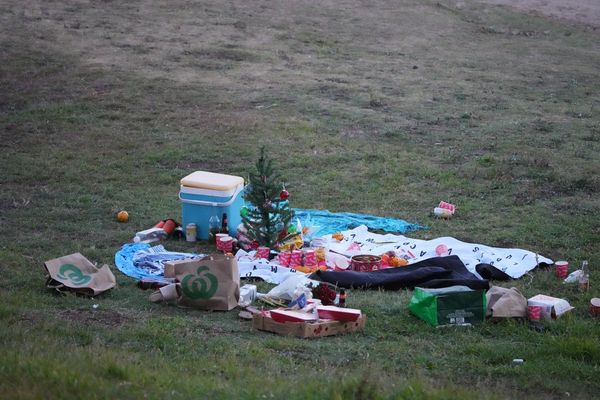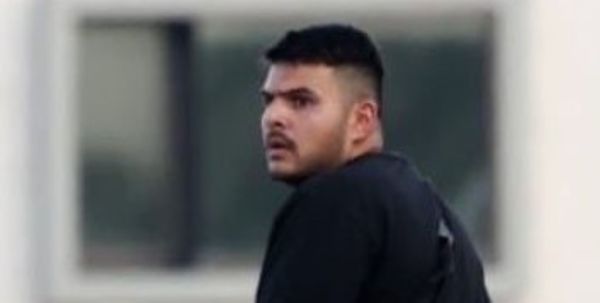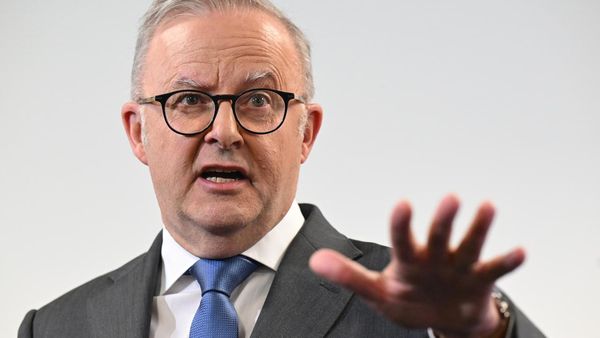
There was a time when Gail Richardson might have struggled to make it past the heroin dealer working a busy corner on Chicago’s West Side without buying a hit.
Richardson spent half a lifetime getting high, dealing in cocaine and heroin to pay for her habit, and then serving a lengthy stint in federal prison. Now the 67-year-old is back on those same streets, greeting the occasional familiar face from the old days still under the crush of addiction.
But this time Richardson is clean and in the business of saving lives as deaths from opioids surge in Black communities that once were thought to have escaped the worst ravages of the most severe drug epidemic in US history.
“The drug has changed. Back then heroin never made you slap yourself upside your head. Back then you didn’t have fentanyl trying to kill you,” she says.
Richardson and the dealer, a man in his 30s with a thin beard, look past each other as he paces a street running under the elevated train tracks next to the Pulaski station while Richardson accosts his customers. But they both know why the other is there.
The dealer is peddling the drugs that have turned the West Side into what the Illinois governor, JB Pritzker, described as the epicenter of the opioid crisis in the state. Richardson is trying to keep the customers alive by distributing a medication, naloxone, that can bring people who have overdosed back from the brink of death in seconds.
Richardson is putting her own years of experience dealing on the streets to work with the West Side heroin/opioid taskforce set up in response to a surge in drug deaths in Chicago’s Black neighborhoods.
Overdoses have killed more than 1 million Americans since the late 1990s, the vast majority from opioids. The numbers have been driven ever higher in recent years by fentanyl, a synthetic opioid up to 100 times more powerful than morphine.
The drug is popular with cartels because its strength allows it to be manufactured in much smaller quantities which are easier to smuggle into the US. It is then laced into heroin, cocaine and methamphetamine to boost their power and value. But because fentanyl is so strong it is far easier to overdose from it than other substances.
The drug was responsible for the majority of overdoses that killed a record 110,000 Americans last year. Fentanyl is now the leading cause of death of American adults under 45 years old, killing twice as many younger people as Covid-19 at the height of the pandemic.
There is no end in sight. A study in the Lancet last year predicted that opioids will claim another 1.2 million lives in the US and Canada by the end of this decade.
Keith Davis is another former heroin user working with the West Side taskforce handing out naloxone and test strips to detect fentanyl and xylazine, a powerful sedative also known as tranq, as a few steps away customers speak to a young man who gives hand signals to the dealer and the product arrives.
“It’s just a big difference. In the late 80s and early 90s when we tooted dope it was sort of relaxing. It was like riding a surfboard. Enjoy the wave. It was cool. This shit now, my God. Seeing the effects it has on people now reminds me when I smoked PCP. People hitting themselves. Real violent. Animated,” says Davis.
For a while, it appeared that many Black urban communities were less affected by opioids than other parts of the US. The initial surge in addiction and death through the 2000s hit rural white communities the hardest after they were targeted by the pharmaceutical industry because states such as West Virginia had higher rates of manual labour and therefore increased demand for prescription painkillers.

Marjorie Gondré-Lewis, professor of anatomy at Howard University’s College of Medicine and co-author of a recent study on the toll of opioid overdoses on Black communities, says racism also played its part. Studies show that Black patients were significantly less likely than whites to be prescribed opioids because of prejudices within the medical profession, including a belief among some doctors that African Americans are more likely to abuse drugs or have a higher tolerance for pain.
“There are doctors who think that Black people don’t feel pain the same way. So if a person comes in and complains about pain, they’re less likely to be prescribed an opiate or morphine,” says Gondré-Lewis.
But if that unintentionally provided some respite from the prescription opioid crisis, the re-emergence of heroin and the arrival of fentanyl in the mid-2010s shifted the landscape dramatically.
In 2015, heroin overtook prescription painkillers as the leading cause of drug overdose deaths. The following year, fentanyl surged past both of them. Since then, Black overdose deaths in Illinois have risen three times faster than those of whites. The state now has the highest proportion of African American opioid deaths in the country and drugs now kill more people in Illinois than murders or traffic accidents combined.
Taskforce members and researchers say the surge in overdose deaths in Black communities is in part driven by a mix of drugs becoming more dangerous alongside deepening social issues including rising numbers of people without homes or medical care. All of that was compounded by the coronavirus pandemic, which increased isolation and cut those already in treatment off from support.
Fentanyl also poses a particular danger to an older generation of Black men who have used heroin for decades and knew how much they could tolerate without overdosing but can no longer use it safely because of fentanyl. It is one reason why Black overdose deaths have risen most sharply among middle-aged men between 45 and 64 years old whereas the largest increase in the white community is among those between 25 and 34 years old.
Richardson, Davis and their taskforce colleagues set up a table with naloxone, which is more commonly known by its brand name Narcan, at the bottom of the steps to the Pulaski station outside a liquor store in the West Garfield neighborhood. They hang a sign: “I have Narcan. I am trained to help with an overdose. Please ask for my help!”
“The dealers know who we are,” says Richardson. “We tell them we’re not here to move in on your business. We’re here to save lives because of the epidemic. We have a lot of drug dealers that say, ‘OK, give me a kit, show me how to use it.’”
Now that she’s on the other side, Richardson is disturbed at the risk the passing drug buyers take.
“Most of them know there’s fentanyl in the dope. That’s why they come get the Narcan, because they know. But they’ve spent the money, they’re gonna use the dope anyway. You can’t stop them,” she says.

Luther Syas, the taskforce’s outreach director, says he’s also seen a shift among some drug users from fear of fentanyl to searching out the drug because it gives a bigger hit.
“A lot of them will tell you that they are looking for fentanyl. They will go for the fentanyl because they figure they can handle it whereas they say a person that overdosed, or even died, didn’t know how to handle it. It’s not true but they say it,” he says.
A woman in her 20s called Natasha is crouched against a wall in the Austin neighbourhood, which has one of the highest rates of overdose deaths in Chicago. She is not one of those looking for fentanyl but says she needs a hit and calculates that whatever she buys will come with the deadly opioid.
Natasha, who is warm and soft-spoken but looks exhausted, is waiting for someone she says owes her money which she then plans to spend on heroin whatever the risk. But it is a risk she thinks she can counter.
“I won’t use here. I’ll go back [home]. We have Narcan. We watch each other,” she says.
Still, Natasha knows of a young man who overdosed and died in an apartment on her block.
“I don’t know if he had Narcan. I’m counting on the Narcan,” she says.
That is why Richardson and the rest of the taskforce are out on the streets most days waylaying any passing prospect. A 20-year-old man tells her he’s not a drug user himself but spent his supply of the antidote to save the life of a woman he saw overdosing in an alleyway a couple of weeks earlier.
A little while later, Richardson approaches a man who looks in a bad way. He tells her he wants to get out from under the drugs but says he has a more immediate priority: “I have to get my sick off.” He needs a hit because he’s suffering without it.
“I understand that,” says Richardson. “People are very upfront about saying that they don’t want to go to treatment. That they want to get high. The biggest fear is the withdrawal, that experience of being sick.”
Still, there is a steady stream of takers for the Narcan, whether they are drug users or know someone who is. A recent poll found that three in 10 Americans say they or someone in their family have been addicted to opioids.
By the time the group packs up the table after a morning at two locations, Gail has recorded the details of 11 people who asked for naloxone. Three of them say they need more because they used up an earlier supply to save a life.
The West Side heroin/opioid taskforce, funded with Illinois government state grants, recruits recovering drug users like Richardson and Davis to offer Narcan and help getting treatment because they have been there and are known in the community.
“I have to tell my story a lot of days because that might help them get in rehab, detox, in order to get to recovery,” says Richardson. “I tell them I have been on the West Side all my life. I was a drug dealer and a drug user. I snorted heroin. Five grammes of dope a day. I had a $500-a-day habit.”
For two decades, Richardson had a secure job working for the Illinois Bell phone company. But her dependency on heroin was so evident that her bosses tried to steer her into rehab, but she didn’t want to go. So she took early retirement and decided to become a drug dealer.
Richardson set herself up on a corner in the Austin neighbourhood but didn’t know what she was doing. Then the dealer who claimed the area as his own pulled up.
“He said, ‘How would you like to be a runner? You bring the bundles out and distribute them to the workers and we’ll pay you $500 a week and every bag of dope that’s open is yours at night’,” she says.
“Ding, a light went off. I get all these free drugs. So after that I become well known on the West Side. I started shaking dope for people, putting it together. They paid me $5,000 to shake 100 grammes of dope. So I got associated with so many drug dealers. I told them I don’t want to know nothing about no shooting. Don’t talk about that around me. I’m just here to do a job and leave.”
But Richardson knew.
Seven years in to this life, it caught up with her. The state police were watching.
“They catch me with a kilo of cocaine, 500 grammes of heroin in the house. And I had guns. We had this white girl that used to go buy guns for us. We paid her in drugs,” she says.
Prosecutors asked for 30 years. Richardson was lucky to walk away with 15.
“The judge gave a speech I will never forget. He talked about how I’ve worked all my life. He felt like I got caught up in this drug thing. He said, ‘I can’t give her 30 years. I don’t think she deserves 30 years.’ He said, ‘I’m gonna give her 15,’ and he wished me luck. Tears was rolling down from my eyes,” she says.
Still, 15 years is a long stretch. These days Richardson recognises that it was hardest on her son, who was a teenager when she went away, although she wasn’t thinking of him at the time.
“I sent him through some trauma. I’m not thinking about all that. I’m thinking about me. Selfish,” she says.
Richardson was released in 2016 just short of completing 13 years in prison. She emerged to a drastically changing world of addiction.
Outside the Pulaski station, Richardson accosts a man in a beanie who is glassy-eyed and slurring. He looks middle-aged but is younger. She draws out his story and the man says that one of the reasons he uses drugs is to dull the pain of living on the streets.
Richardson tells the man she can get him into a Salvation Army shelter and help with his addiction. It takes a while but she persists, gently nudging him with stories of her own, until they walk off together on what she hopes will be a first step to freedom from heroin.







